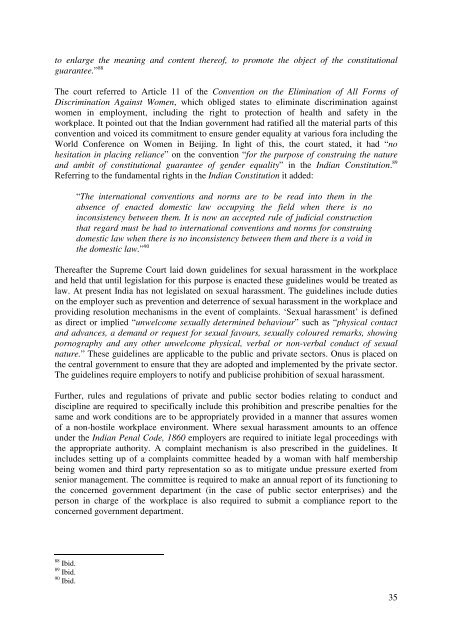SEXUAL HEALTH AND HUMAN RIGHTS A legal and ... - The ICHRP
SEXUAL HEALTH AND HUMAN RIGHTS A legal and ... - The ICHRP
SEXUAL HEALTH AND HUMAN RIGHTS A legal and ... - The ICHRP
You also want an ePaper? Increase the reach of your titles
YUMPU automatically turns print PDFs into web optimized ePapers that Google loves.
to enlarge the meaning <strong>and</strong> content thereof, to promote the object of the constitutional<br />
guarantee.” 88<br />
<strong>The</strong> court referred to Article 11 of the Convention on the Elimination of All Forms of<br />
Discrimination Against Women, which obliged states to eliminate discrimination against<br />
women in employment, including the right to protection of health <strong>and</strong> safety in the<br />
workplace. It pointed out that the Indian government had ratified all the material parts of this<br />
convention <strong>and</strong> voiced its commitment to ensure gender equality at various fora including the<br />
World Conference on Women in Beijing. In light of this, the court stated, it had “no<br />
hesitation in placing reliance” on the convention “for the purpose of construing the nature<br />
<strong>and</strong> ambit of constitutional guarantee of gender equality” in the Indian Constitution. 89<br />
Referring to the fundamental rights in the Indian Constitution it added:<br />
“<strong>The</strong> international conventions <strong>and</strong> norms are to be read into them in the<br />
absence of enacted domestic law occupying the field when there is no<br />
inconsistency between them. It is now an accepted rule of judicial construction<br />
that regard must be had to international conventions <strong>and</strong> norms for construing<br />
domestic law when there is no inconsistency between them <strong>and</strong> there is a void in<br />
the domestic law.” 90<br />
<strong>The</strong>reafter the Supreme Court laid down guidelines for sexual harassment in the workplace<br />
<strong>and</strong> held that until legislation for this purpose is enacted these guidelines would be treated as<br />
law. At present India has not legislated on sexual harassment. <strong>The</strong> guidelines include duties<br />
on the employer such as prevention <strong>and</strong> deterrence of sexual harassment in the workplace <strong>and</strong><br />
providing resolution mechanisms in the event of complaints. ‘Sexual harassment’ is defined<br />
as direct or implied “unwelcome sexually determined behaviour” such as “physical contact<br />
<strong>and</strong> advances, a dem<strong>and</strong> or request for sexual favours, sexually coloured remarks, showing<br />
pornography <strong>and</strong> any other unwelcome physical, verbal or non-verbal conduct of sexual<br />
nature.” <strong>The</strong>se guidelines are applicable to the public <strong>and</strong> private sectors. Onus is placed on<br />
the central government to ensure that they are adopted <strong>and</strong> implemented by the private sector.<br />
<strong>The</strong> guidelines require employers to notify <strong>and</strong> publicise prohibition of sexual harassment.<br />
Further, rules <strong>and</strong> regulations of private <strong>and</strong> public sector bodies relating to conduct <strong>and</strong><br />
discipline are required to specifically include this prohibition <strong>and</strong> prescribe penalties for the<br />
same <strong>and</strong> work conditions are to be appropriately provided in a manner that assures women<br />
of a non-hostile workplace environment. Where sexual harassment amounts to an offence<br />
under the Indian Penal Code, 1860 employers are required to initiate <strong>legal</strong> proceedings with<br />
the appropriate authority. A complaint mechanism is also prescribed in the guidelines. It<br />
includes setting up of a complaints committee headed by a woman with half membership<br />
being women <strong>and</strong> third party representation so as to mitigate undue pressure exerted from<br />
senior management. <strong>The</strong> committee is required to make an annual report of its functioning to<br />
the concerned government department (in the case of public sector enterprises) <strong>and</strong> the<br />
person in charge of the workplace is also required to submit a compliance report to the<br />
concerned government department.<br />
88 Ibid.<br />
89 Ibid.<br />
90 Ibid.<br />
35

















